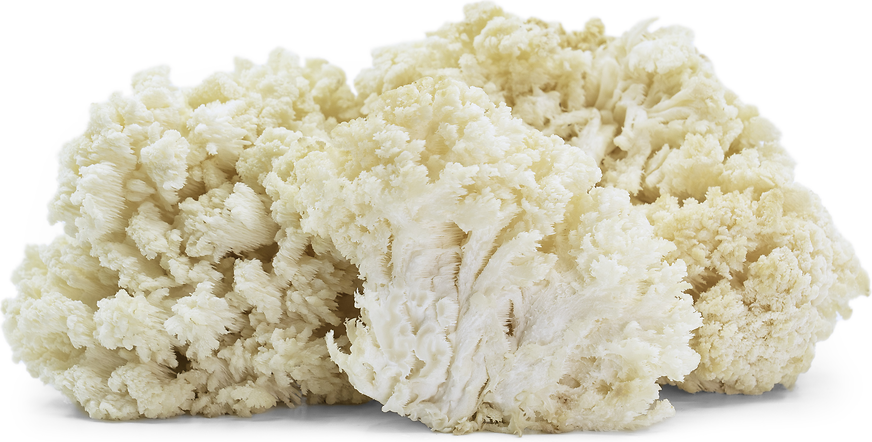


Coral Mushrooms
Estimated Inventory, lb : 0
Description/Taste
Crown-Tipped Coral mushrooms are small to medium in size, averaging 2-8 centimeters in diameter and 5-12 centimeters in length, and have very short stems with multiple thin branches growing upwards. The fruiting body ranges in color from pale cream to tan, and as it matures, it will turn more yellow and develop a slight pink hue. Each tubular branch has a smooth appearance and is topped with a small depression surrounded by 3-6 points, giving it a distinct crown-like appearance. The branched stalks have a firm texture, despite the whole mushroom being relatively fragile. Crown-Tipped Coral mushrooms have an earthy aroma, are tender and delicate, and offer a mild, woodsy flavor with a slight peppery aftertaste.
Seasons/Availability
Crown-Tipped Coral mushrooms are available in the early summer through fall.
Current Facts
Crown-Tipped Coral mushrooms, botanically classified as Artomyces pyxidatus, are an edible variety named for their coral-like appearance and are a foraged variety not currently being cultivated. Crown-Tipped Coral mushrooms are one of many different species of coral-type fungi and are one of the few found growing directly on the fallen or dead hardwood, particularly aspen, oak, poplar and willow trees. They are sometimes referred to as Candelabra mushrooms and are grouped with other visually similar species as part of the “clavarioid fungi” group. Extreme caution should be taken when foraging for this variety as there are many similar species that are inedible and toxic. Avoid brightly colored mushrooms as the white, beige, or yellow Crown-Tipped Coral mushrooms are the only varieties that are edible. When purchased from a reputable seller, Crown-Tipped Coral mushrooms are favored for their unusual shape and are commonly used as a garnish for soups and seafood dishes.
Nutritional Value
Crown-Tipped Coral mushrooms contain protein, potassium, and trace amounts of copper, magnesium, and calcium. They also contain essential amino acids and antioxidant and antibacterial properties.
Applications
Crown-Tipped Coral mushrooms can be consumed raw but are most often cooked as they can cause an upset stomach in some consumers. The mushrooms need to be thoroughly washed, as dirt can get lodged among the branches and between the small points at the tip of each stalk. To wash, they should be pulled apart into pieces and agitated in a bowl of water. Crown-Tipped Coral mushrooms are delicate and will soften and wilt quickly when heated, so they are often used as a finishing garnish in soups, stews, and stir-fries. They can also be lightly battered and fried to serve as an appetizer, sautéed and served alongside fish or seafood as a play on coral in an under the sea theme, or pickled and preserved for later use. Crown-Tipped Coral Mushrooms pair well with lettuce, bok choy, snap peas, green beans, cherry tomatoes, vinaigrette, miso soup, tofu, soy sauce, mirin, seafood such as white fish, prawns, shrimp, and crab, and meats such as poultry, beef, and pork. They will keep for a couple of days when stored in a paper bag in the refrigerator and up to six weeks when pickled.
Ethnic/Cultural Info
The man credited with the name and discovery of Crown-Tipped Coral mushrooms, Elias Magnus Fries, was considered by many of his contemporaries as “the Linnaeus of Mycology.” His major contribution to the study of mycology was through better ways of organizing the different genera and species and was the first to use spore color as a basis for classifying gilled mushrooms. Crown-Tipped Coral mushrooms are one of the many types of mushroom that were reclassified once advancements in microscopes and DNA sequencing enabled mycologists to confirm the differences between the different club and coral fungi genera and species. Crown-Tipped Coral mushrooms were moved from the Clavaria genus to Clavicorona in 1947, and then to the genus Artomyces in 1972. Today they are often still known and classified as Clavicorona pyxidate among some foragers.
Geography/History
Crown-Tipped Coral mushrooms were first recorded by Swedish botanist Elias Magnus Fries in 1821 and are commonly found throughout the temperate regions of the Northern Hemisphere. Today Crown-Tipped Mushrooms can be found at farmers markets and specialty grocers in the United States, primarily east of the Rocky Mountains, and also in Europe, China, Russia, Costa Rica, and Mexico.
Recipe Ideas
Recipes that include Coral Mushrooms. One
Podcast




